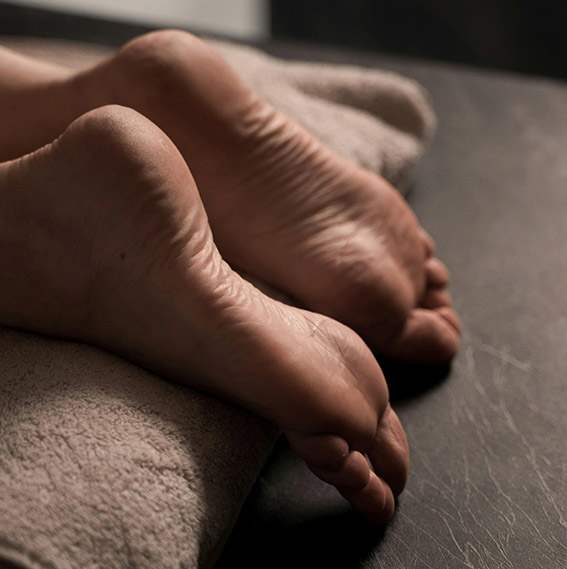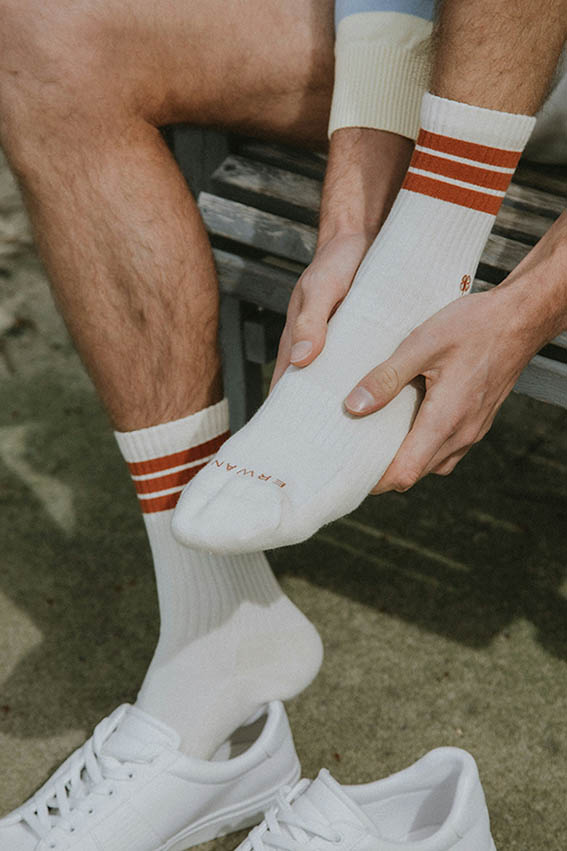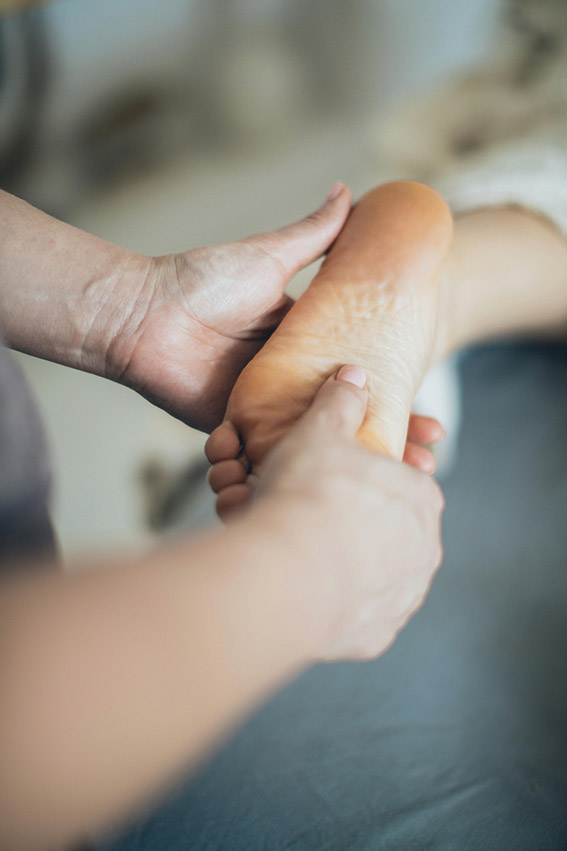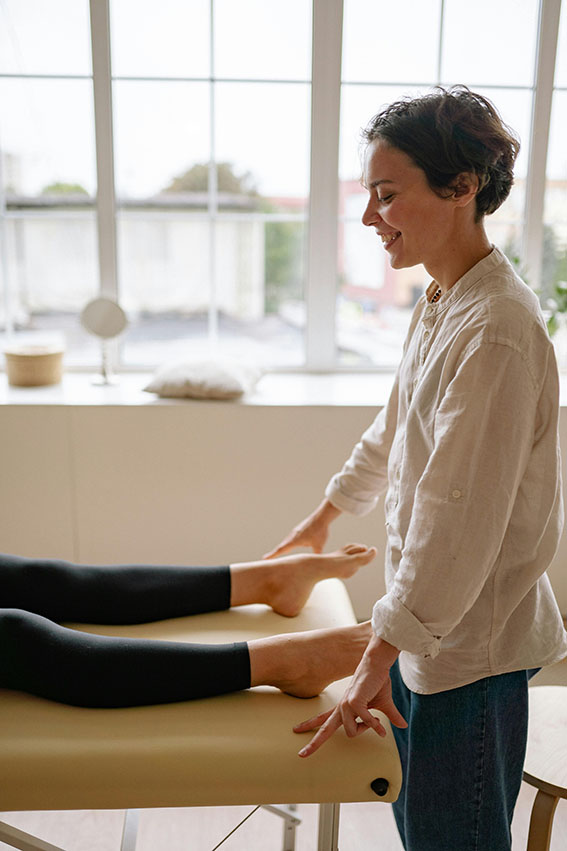Arch Pain Treatment
Have you been dealing with foot arch pain? Arch pain can make walking, standing, performing any physical labor, or participating in sports difficult. There are several causes for pain in the arches of your feet. Some may surprise you, but first, a brief overview of the foot structure.
Foot Arch Anatomy
Your foot is composed of 26 small bones. The arch extends from the ball of the foot toward the heel and from the inner edge to the middle of your foot. The arch is easier to see if you wet your feet and walk on dry pavement. You’ll see the characteristic dip on the inside of the footprint where the foot arch doesn’t touch the ground.
The arch maintains its shape due to the shape of the bones in the midfoot and how they fit together, along with a network of fibrous tissues (ligaments) that connect the bones to each other.
Supporting the bones are muscles that control movement, fat pads to absorb impact and prevent pressure sores, and a tough tissue called the plantar fascia.
Together, these structures flex and tighten to cushion your steps. They help you adjust to uneven terrain without injury and act as a springboard as you walk, jog, or run. You’ll begin to notice pain if the structures are out of alignment through fallen arches, the tissues are inflamed, or you’ve strained or sprained the connecting tissues. When you feel that pain, don’t ignore it. It’s time to seek arch pain treatment.


What Causes Arch Pain?
This is not an easy question because there’s often more than one cause at play. Here are a few general causes behind arch pain.
- Trauma: Direct trauma to the foot from a single blow or due to unusual sustained force can inflame the plantar fascia, the thick supportive tissue supporting the bones and tissues in the arch. Inflammation in this tissue is called plantar fasciitis, and it can be extremely painful.
- Overuse Fractures: When the body repeatedly handles too much stress, or the stress hits the bones from the wrong angle due to misalignment, the bones can crack. Continued use will create increasingly painful arches as the bone continues to deteriorate.
- Body Alignment: The body is a fine-tuned instrument, but if anything is out of alignment, it affects all of the mechanics of the feet, ankles, knees, hips, and spine. Tight calf muscles could pull on the structures of the foot, for example, and cause the arch to collapse over time.
- Collapsed Arches: Arches can fall over time, but in some cases, people are afflicted with them from the earliest ages. Flat feet may be inherited from parents or may come with some other genetic condition. Flat feet are only a problem if you experience discomfort, at which point you can seek medical attention.
- Shoes: Wearing ill-fitted or poorly designed shoes for extended periods can cause arch pain. So can wearing raised heels for extended periods. Your stilettos may look nice, but over time, they can shorten the calf muscles, which pulls the foot out of alignment and leads to arch pain.
- Sprains and Strains: The tendons and ligaments that support the joints and hold the bones in position can only stretch so far without causing damage. A sudden misstep could cause them to stretch beyond their limits and damage or tear the fibers.
- Arthritis: Inflammation in and around the foot joints can be acute or chronic, causing pain and deterioration of the cushioning cartilage and joint. Midfoot arthritis is common and can develop over years of too much wear and tear on the feet. It can result in a weakened or collapsed arch and intense pain, especially when standing or walking. Rheumatoid arthritis can also accelerate foot pain. This chronic inflammatory condition can compromise the ligaments that support the midfoot, causing the arches to collapse and pain to kick into high gear.
We at Foot & Ankle Center understand there could be multiple causes for your pain. Our arch pain doctors in Mesquite, Nevada, and St. George, Utah, will thoroughly examine the root cause of your arch pain and develop a treatment plan tailored to your needs.
Arch Pain Treatment
Different causes of arch pain will necessitate different treatment protocols. Here’s a closer look:
Trauma: Whether you step on a nail, drop a brick on your foot, or suffer impact trauma from a car accident, trauma can damage the skin, fascia, muscles, ligaments, and bones. Pain will be localized to the site of damage, though depending on severity, your foot can swell across a larger area.
If you feel you can treat the damage at home, here are some things to keep in mind.
- Any puncture wound can lead to infection. Keep it clean, dry (except for antibiotic ointment), and covered.
- Change the dressing if the dressing gets soiled or wet.
- Three times a day, reapply the antibiotic ointment and check the wound for signs of infection. If the area feels hot to the touch, the redness spreads rather than getting smaller, or you experience signs of illness like a fever and chills, nausea, weakness, etc., seek immediate medical attention. A walk-in appointment with your arch pain specialist would work, or go to the emergency room, as infections can lead to blood poisoning and even death if not treated.
- If pain increases over time rather than decreases, there might be more going on than meets the eye. Seek arch pain treatment for a thorough examination.
Depending on the type of damage, arch pain treatment may be as simple as getting a tetanus shot for the nail wound and letting the foot heal. In some cases, you may need to get surgery in order to piece together the broken bone.

Dr. Cameron takes a conservative approach to arch pain treatment and will exhaust all other less invasive alternatives before recommending surgery. As a member of the American Podiatric Medical Association, Dr. Cameron has treated a wide variety of injuries and conditions. Every patient is unique, and there are no cookie-cutter solutions.
Plantar Fasciitis: The plantar fascia runs from the heel to the ball of the foot and is a thick, sinewy layer between the skin of the foot arch and the bones of the middle foot. It often presents first thing in the morning. After you’ve slept and otherwise feel good, you take the first few steps out of bed and feel intense pain in the foot’s arch and heel.
Generally, the pain starts because you expect more from the fascia than it can comfortably do, like going on an unusually long hike you weren’t prepared for. You build up strength and resilience over time. By doing too much all at once, the fascia gets inflamed. After overuse, you lie down for the night, and your foot falls forward. The fascia tightens while you sleep. That first step out of bed in the morning stretches the fascia out again, and it can take a while before it feels limber.
Try working with your feet before getting out of bed to ease discomfort. Flex your foot toward your shin and gently press the heel of your hand against the bottom of your toes to stretch the fascia. Hold for a few seconds and repeat until your foot feels more relaxed.
Sprains and Strains: Sudden unusual movements, like stepping wrong on an uneven surface, can cause the foot to flex or twist against its natural mechanics and can strain the ligaments attaching the little bones in the midfoot. This can result in local tenderness, including around the arch.
Minor strains and sprains are best treated with R.I.C.E.
- Rest: Limiting the use of the damaged foot will give it time to heal. The use of crutches will allow you to go about your day without putting pressure on the injured ligaments. If you’d prefer not to use crutches, you can get a four-wheeled scooter. You can kneel on the pad and push with your good foot. The scooter is especially helpful for people with more active jobs or those with balance issues.
- Ice: The cold from ice (or frozen gel packs) eases discomfort and reduces swelling and inflammation. Direct contact with ice for long periods can cause superficial damage to the skin, so wrap the ice in a thin towel and limit use to 15 minutes at a time.
- Compression: Compression bandages limit the movement of damaged ligaments, so they have time to heal. Wrap the injured foot snugly but not so tightly that you can’t get three fingers under the secured wrap; otherwise, you cut off circulation.
- Elevation: By elevating the injured foot above the heart, the blood that would swell the foot (and make it throb) returns to the heart for redistribution.
If R.I.C.E. doesn’t produce marked improvement in your arch pain in 2 to 4 weeks, it’s time to check with your arch pain specialist. You may have a torn ligament or additional damage.
Midfoot Arthritis: When the cartilage between the bones of the middle foot breaks down, you can have pain on the top of the foot and in the arch, localized swelling, and pain in the midfoot when you walk and push off from your toes. An x-ray will detect the presence of arthritis, bone spurs, and deformities that could lead to arch pain.
Rocker-soled shoes or custom orthotics can be very helpful in lessening symptoms. They aid in movement, cushion damaged bone, and protect any bone spurs or other deformities caused by arthritis.
Over-the-counter anti-inflammatories, acetaminophen, or topical anti-inflammatory creams can help patients find more comfort. Your arch pain specialist may also prescribe pharmaceutical-grade medications. In extreme cases, Dr. Cameron can surgically fuse damaged bone with specially designed plates to prevent further harm and ease discomfort.
Overuse Fractures: Unusual or extended stress on the bones in the foot arch can cause microfractures. The fractures spread if you keep using them while injured rather than allowing them to rest and heal. Pain is often localized to the damaged bone and worsens with time rather than getting better. Your doctor might recommend a cast or walking boot to protect the foot arch while it heals.
Levels Of Pain
When describing your pain to your doctor, it can be helpful to indicate the level of activity you can endure because of your injury.
- You experience pain only during activity.
- You feel pain before and after the activity. However, you are still able to function normally throughout the activity.
- The pain comes before, during, and after the activity. You are still able to participate, but you’re not operating at full capacity.
- You are so uncomfortable that you won’t even try to participate.
When Should I Seek Arch Pain Treatment In Mesquite or St. George?
A general rule of thumb is to seek a professional evaluation if arch pain interferes with your life, if it forces unnatural adaptation in the way you move or stand, or if the pain isn’t going away in the expected time frame of a minor injury.
What Can I Expect At My Examination
Most arch pain doctors will start your exam by gathering a thorough medical history. During the examination, they will check the alignment of your ankles as you stand and walk. They will move your foot, checking for tender spots, range of motion, palpable breaks, or deformities caused by the injury. They may also check your pulse and reflexes.
If your doctor suspects arthritis or a bone injury, they might order an x-ray to get a clearer picture of the injury. If they think it is a torn ligament or soft tissue injury, they may order an MRI. It will depend on the type and severity of symptoms and the way these symptoms present themselves.
After the exam, your doctor will work with you to come up with a tailor-made recovery plan that may include:
- Physical therapy to strengthen and balance muscles supporting the foot arch. Weaker muscles can cause stronger muscles to compensate, resulting in disproportionate tension. Physical therapy exercises can shore up weak muscles, bolstering your arch and reducing arch pain.
- Orthotic shoes or after-market insoles to correct foot alignment and arch comfort. These can give your arch the support it needs, both as you heal and beyond.
- Other corrective devices, like braces. These can also lend added support during recovery.
- Anti-inflammatory or pain medications as needed.
- Medical interventions and surgical options. A doctor can evaluate your needs for arch pain treatment and determine if drastic interventions, such as surgery, are appropriate.

Why the Foot & Ankle Center for Arch Pain Treatment?
While we wouldn’t wish injury on anyone, we are here to help you heal. You can trust the Foot & Ankle Center medical team to be thorough and skilled. Dr. Cameron has practiced podiatry since 2016. He opened his first clinic in Mesquite, Nevada, in 2021 and a second location in St. George, Utah, in 2023. He is deeply dedicated to the communities he serves.
Dr. Cameron is affiliated with medical facilities at Mesa View Regional Hospital, St. George Regional Hospital, and Cedar City Hospital.
We strive to correct damage caused by injury, improve overall function, increase comfort, and get you back to doing what you love to do. Let our arch pain treatment specialists in Mesquite and St. George get you back on your feet for good.
To learn more about Dr. Cameron or to schedule an appointment at our offices in Mesquite, NV, or St. George, UT, contact us via our website or call us at (435) 714-6996.
